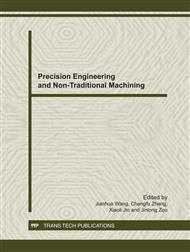p.227
p.232
p.236
p.241
p.245
p.250
p.255
p.259
p.264
Investigation of Mass Sensitivity for the Piezoelectric Diaphragm Biosensor
Abstract:
The mass sensitivity of a piezoelectric diaphragm biosensor has been investigated. The piezoelectric diaphragm utilizing a flexural vibration mode is an acoustic wave device which can be immobilized with a bio-molecular recognition layer on its surface. The mass sensitivity of the sensor was analyzed by the approximately theoretical and FEM methods, respectively. The sensitivity formula expressed by the structural parameters and the material parameter was educed for easy computing. The procedure utilizing Rayleigh method for the analytic solution of the sensitivity was introduced. The expression was verified by using a commercial FEM software package, ANSYS. The simulations are well consistent with the theory.
Info:
Periodical:
Pages:
245-249
Citation:
Online since:
November 2011
Authors:
Price:
Сopyright:
© 2012 Trans Tech Publications Ltd. All Rights Reserved
Share:
Citation:


